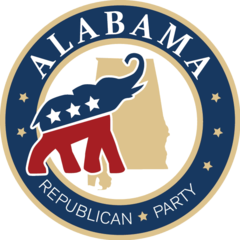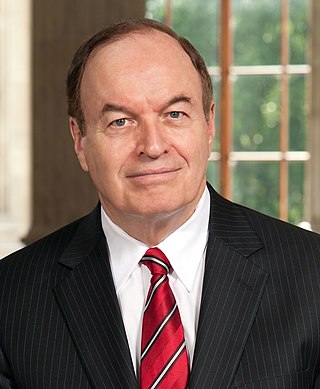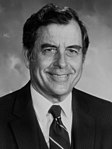
James Elisha 'Jim' Folsom Jr. is an American politician who was the 50th governor of Alabama from April 22, 1993, to January 16, 1995. He has also served as the lieutenant governor of Alabama on two occasions. He is a member of the Democratic Party.

The 1998 United States Senate elections were held on November 3, with the 34 seats of Class 3 contested in regular elections. This was seen as an even contest between the Republican Party and Democratic Party. While the Democrats had to defend more seats up for election, Republican attacks on the morality of President Bill Clinton failed to connect with voters and anticipated Republican gains did not materialize. The Republicans picked up open seats in Ohio and Kentucky and narrowly defeated Democratic incumbent Carol Moseley Braun, but these were cancelled out by the Democrats' gain of an open seat in Indiana and defeats of Republican Senators Al D'Amato and Lauch Faircloth. The balance of the Senate remained unchanged at 55–45 in favor of the Republicans.

The 1996 United States Senate elections were held on November 5, with the 33 seats of Class 2 contested in regular elections. Special elections were also held to fill vacancies. They coincided with the presidential election of the same year, in which Democrat Bill Clinton was re-elected president.

The 1986 United States Senate elections were elections for the United States Senate. Held on November 4, in the middle of Ronald Reagan's second presidential term, the 34 seats of Class 3 were contested in regular elections. The Republicans had to defend an unusually large number of freshman Senate incumbents who had been elected on President Ronald Reagan's coattails in 1980. Democrats won a net of eight seats, defeating seven freshman incumbents, picking up two Republican-held open seats, and regaining control of the Senate for the first time since January 1981. This remains the most recent midterm election cycle in which the sitting president's party suffered net losses while still flipping a Senate seat.

The 1984 United States Senate elections were held on November 6, with the 33 seats of Class 2 contested in regular elections. They coincided with the landslide re-election of President Ronald Reagan in the presidential election. In spite of the lopsided presidential race, Reagan's Republican Party suffered a net loss of two Senate seats to the Democrats, although it retained control of the Senate with a reduced 53–47 majority. Democrats defeated incumbents in Illinois and Iowa, and won an open seat in Tennessee, while Republicans defeated an incumbent in Kentucky.

The 1980 United States Senate elections were held on November 4, coinciding with Ronald Reagan's victory in the presidential election. The 34 Senate seats of Class 3 were contested in regular elections. Reagan's large margin of victory over incumbent Jimmy Carter gave a huge boost to Republican Senate candidates, allowing them to flip 12 Democratic seats and win control of the chamber for the first time since the end of the 83rd Congress in January 1955.

The 1978 United States Senate elections were held on November 7, in the middle of Democratic President Jimmy Carter's term. The 33 seats of Class 2 were contested in regular elections. Special elections were also held to fill vacancies.

The 1972 United States Senate elections were held on November 7, with the 33 seats of Class 2 contested in regular elections. They coincided with the landslide re-election of Republican President Richard Nixon. Despite Nixon's landslide victory, Democrats increased their majority by two seats. The Democrats picked up open seats in Kentucky and South Dakota, and defeated four incumbent senators: Gordon Allott of Colorado, J. Caleb Boggs of Delaware, Jack Miller of Iowa, and Margaret Chase Smith of Maine. The Republicans picked up open seats in New Mexico, North Carolina, and Oklahoma, and defeated one incumbent, William B. Spong Jr. of Virginia.

The 1968 United States Senate elections were elections for the United States Senate. Held on November 5, the 34 seats of Class 3 were contested in regular elections. They coincided with the presidential election of the same year. The Republicans picked up five net seats in the Senate. This saw Republicans win a Senate seat in Florida for the first time since Reconstruction.

The Alabama Republican Party is the state affiliate of the Republican Party in Alabama. It is the dominant political party in Alabama. The state party is governed by the Alabama Republican Executive Committee. The committee usually meets twice a year. As of the February 23, 2019 meeting in Birmingham, the committee is composed of 463 members. Most of the committee's members are elected in district elections across Alabama. The district members are elected in the Republican Primary once every four years, with the most recent election for the committee having been on June 5, 2018. The new committee takes office following the general election in November 2018. In addition, all 67 county GOP chairmen have automatic seats as voting members. The state chairman can appoint 10 members. Each county committee can appoint bonus members based on a formula that theoretically could add 312 seats, although that formula currently calls for only about 50 seats.

The 2010 United States Senate election in Alabama took place on November 2, 2010, alongside other elections to the United States Senate in other states, as well as elections to the United States House of Representatives and various state and local elections. Incumbent Republican Senator Richard Shelby won re-election to a fifth term.

The 1980 United States Senate election in Alabama took place on November 4, 1980, alongside other elections to the United States Senate in other states as well as elections to the United States House of Representatives and various state and local elections. Incumbent Democratic U.S. Senator Donald Stewart, elected in a special election to finish the term of the seat left vacant by the death of Senator James B. Allen, decided to run for a full term, but was defeated in the primary by Jim Folsom, who lost the general election to Republican Jeremiah Denton.

The 1986 United States Senate election in California took place on November 4, 1986. Incumbent Democratic U.S. Senator Alan Cranston narrowly won re-election to a fourth and final term over Republican U.S. Congressman Ed Zschau. This was the last time where both major party nominees for the Class 3 Senate seat in California were men until 2022.

The 1968 United States Senate election in Alabama took place on November 5, 1968. Incumbent Democratic U.S. Senator J. Lister Hill retired. He was succeeded by Lieutenant Governor of Alabama James Allen, who won a hotly contested primary over Armistead I. Selden Jr. In the general election, Allen easily defeated Republican Probate Judge Perry O. Hooper Sr. and National Democratic nominee Robert Schwenn.

The 2016 United States Senate election in Alabama was held on November 8, 2016, to elect a member of the United States Senate to represent the State of Alabama, concurrently with the 2016 U.S. presidential election, as well as other elections to the United States Senate in other states and elections to the United States House of Representatives and various state and local elections.

The 1972 United States Senate election in Alabama was held on November 7, 1972.

The 1978 United States Senate election in Alabama was held on November 7, 1978. Incumbent Democratic U.S. Senator John Sparkman decided to retire and Alabama Supreme Court Chief Justice Howell Heflin was elected to succeed him.

The 2022 United States Senate election in Alabama was held on November 8, 2022, to elect a member of the United States Senate to represent the State of Alabama. Incumbent senator Richard Shelby was first elected in 1986 and re-elected in 1992 as a Democrat before becoming a Republican in 1994. In his most recent election in 2016, he was re-elected with nearly 64% of the vote over Democrat Ron Crumpton. In February 2021, Shelby announced that he would not seek re-election to a seventh term, which resulted in the first open Senate seat since 1996 and the first in this seat since 1968.

The 1972 United States Senate election in Arkansas took place on November 7, 1972. Incumbent U.S. Senator John L. McClellan was re-elected to a sixth term in office, defeating U.S. Representative David Pryor in a hotly contested primary. In the general election, McClellan easily defeated Republican physician Wayne Babbitt. This was McClellan's final campaign; he died in his sleep in 1977. Pryor was elected Governor of Arkansas in 1974 and won the race to succeed McClellan in 1978.

The 1978 United States Senate special election in Alabama was held on November 7, 1978. It was a special election to fill the seat which had been held by Senator Jim Allen, who died on June 1. His widow Maryon was appointed on June 8 by governor George Wallace to fill the vacancy until a special election could be held.























